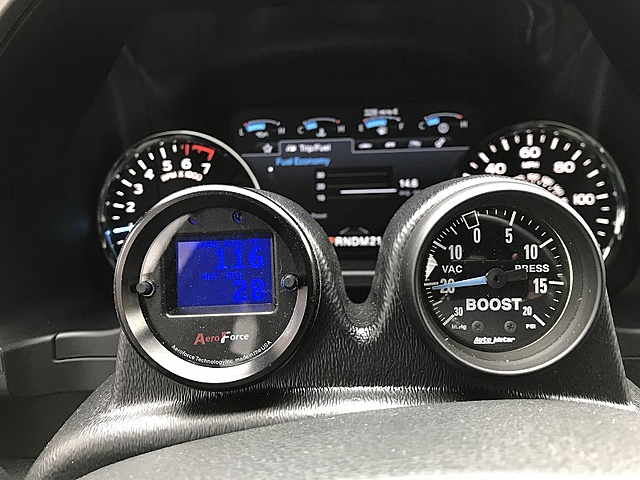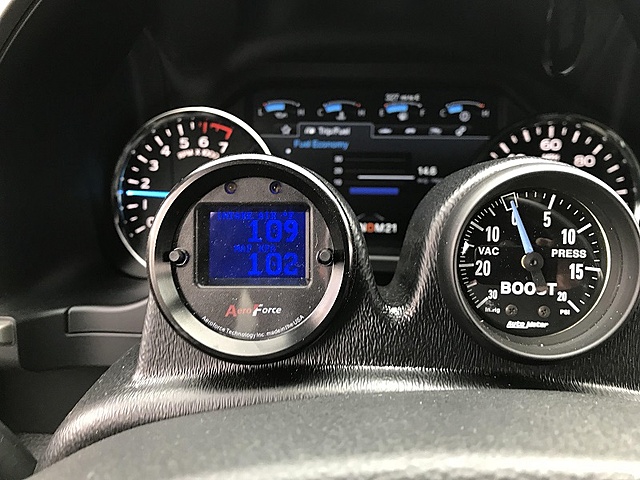2017 2.7L Boost Pressure
#12
Senior Member
Join Date: Mar 2017
Location: South St. Louis county, Mo.
Posts: 1,462
Received 422 Likes
on
302 Posts
It seems to depend on a lot of variables. This morning its a cool and damp 73f and I was surprised when I hit 14lbs in 1st gear and traction control off. I had to back off at about 13lbs in second when I lost traction....damp road.
Before turning off traction control boost was bouncing all over the place in 1st and 2nd as it tried to retain traction.
Truck is stock on 87 octane
Before turning off traction control boost was bouncing all over the place in 1st and 2nd as it tried to retain traction.
Truck is stock on 87 octane
Last edited by KWS 2.7; 10-05-2017 at 11:53 AM. Reason: added info
#13
Senior Member
Thread Starter
I would have be happy to.
#14
Possibly, and a good observation. When I have the time again there is a wealth of information available in the pcm live data that I could use to verify this. 12psi was the desired boost pressure at idle and was being held there via the waste gate duty cycle. So while you are correct that atmospheric pressure may come into play, it also indicates that the turbo pressure is needed to be controlled even at idle.
Regardless, there is much computer intervention happening with boost pressure at all times and much of it available. That was the point of my post. Hopefully I will soon have a 3.5T test mule to compare it to.
Regardless, there is much computer intervention happening with boost pressure at all times and much of it available. That was the point of my post. Hopefully I will soon have a 3.5T test mule to compare it to.
#15
Senior Member
Join Date: Mar 2017
Location: South St. Louis county, Mo.
Posts: 1,462
Received 422 Likes
on
302 Posts
Possibly? Not "possibly," it's just science man. Your sensor is DEFINITELY reading boost plus atmospheric pressure. You are not making any boost at idle. This is a very misleading original post and you should consider editing your numbers based on atmospheric pressure for the day in question. I can just hear it now: "Some guy on the forum was running 33 lbs on a stock 2.7!" I'm guessing 30 psi would turn your 2.7 into a really impressive grenade.
My truck, going off the trucks sensors using the obdlink app and OBDMx scantool shows what you should have at idle, and that's a vacuum or negative pressure. For my truck on this cool day was -9 psi. You should never be seeing boost at an idle.
#16
Senior Member
Thread Starter
My post original post is 100% accurate but you are correct that it may be misleading to some. Thanks for your input and I will take it in consideration. I might edit my original post after I get a chance to monitor the sensor KOEO which is something I should have done in the first place.
I am busy busy busy busy at work but should be able to find some time.
I am busy busy busy busy at work but should be able to find some time.
Possibly? Not "possibly," it's just science man. Your sensor is DEFINITELY reading boost plus atmospheric pressure. You are not making any boost at idle. This is a very misleading original post and you should consider editing your numbers based on atmospheric pressure for the day in question. I can just hear it now: "Some guy on the forum was running 33 lbs on a stock 2.7!" I'm guessing 30 psi would turn your 2.7 into a really impressive grenade.
#17
My post original post is 100% accurate but you are correct that it may be misleading to some. Thanks for your input and I will take it in consideration. I might edit my original post after I get a chance to monitor the sensor KOEO which is something I should have done in the first place.
I am busy busy busy busy at work but should be able to find some time.
I am busy busy busy busy at work but should be able to find some time.

As a side note which is somewhat related, I have one of those AeroForce gauges that plugs into the OBD2 port and outputs everything under the sun. It will give you a MAP reading in kPa, but then separately will also show boost, where it does the math based on atm and outputs in psig(+)/inHg(-). It's a cool thing.
#18
I was one of those who was looking at this in layman's terms, and thought" How is he running positive boost at idle, let alone 12lbs and to be more than double what the factory setup on a 15 EB is running max boost wise. Not implying the OP is trying to get over on anyone or anything of that nature, but I'm thinking for the "normal" audience who look at a boost gauge, then the original post is misleading.
But, all is well and I'm not going crazy thinking I have a janky truck =).
But, all is well and I'm not going crazy thinking I have a janky truck =).
#19
Senior Member
Join Date: Mar 2017
Location: South St. Louis county, Mo.
Posts: 1,462
Received 422 Likes
on
302 Posts
@rts9364. I'm curious, in MAP at idle it will show atmospheric pressure? No change due to vacuum from the engine running? I saw this gage option in the obdlink app and wasnt sure what it did. Forgot about it when I found the boost gauge.
#20
Your question came through right before I left to run an errand, so I took some photos and hope this helps.
Atm. Press right now where I am is 30.05 in. Remember that number.
Here is my truck right after I started it, at idle. The gauge on the left shows MAP in kPa (28). The analog boost gauge on the right shows ONLY vacuum or boost with ATM subtracted. Let's call it 21 in.Hg of vacuum.

So what this means is that there is 28 kPa = 8.3 inHg = 4.08 psi of pressure in the manifold. Period. Absolute. Since that number is less than ATM, we know we have vacuum.
If you subtract atmospheric pressure from the MAP reading, you get 8.3 - 30.05 = -21.75 inHg of vacuum, or the number that the analog gauge is reading.
Now here is a shot when I am climbing a hill, so there is no vacuum, but I am not in it enough to make much boost.

MAP is reading 102 kPa = 30.12 inHg, or just above ATM, so my analog gauge is juuust on the "boost" side of zero.
I was driving around in a small town, so there was not enough room to make any boost for today's demo. Maybe next time.

Does this make sense? It is a bit confusing when vacuum is involved.


